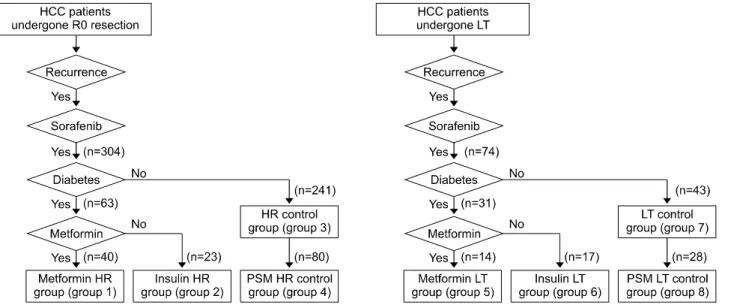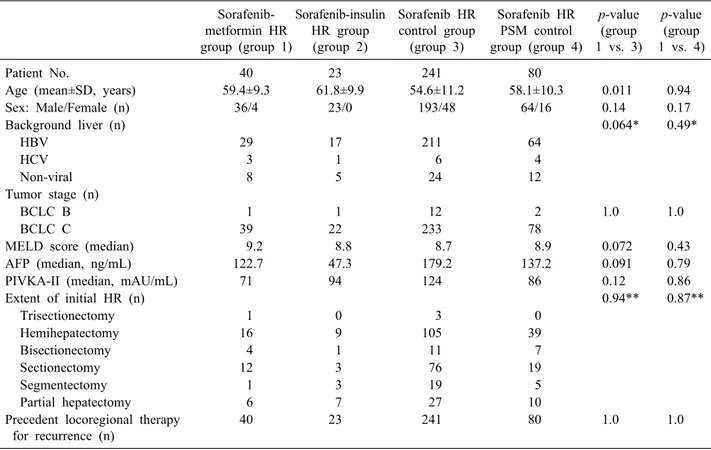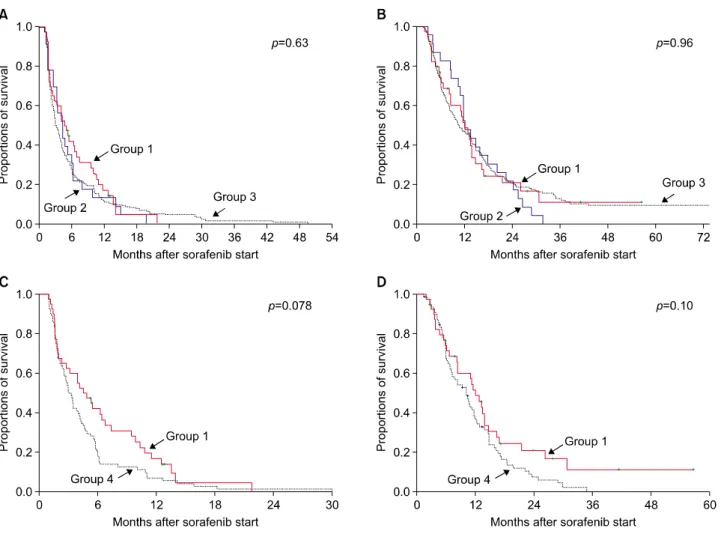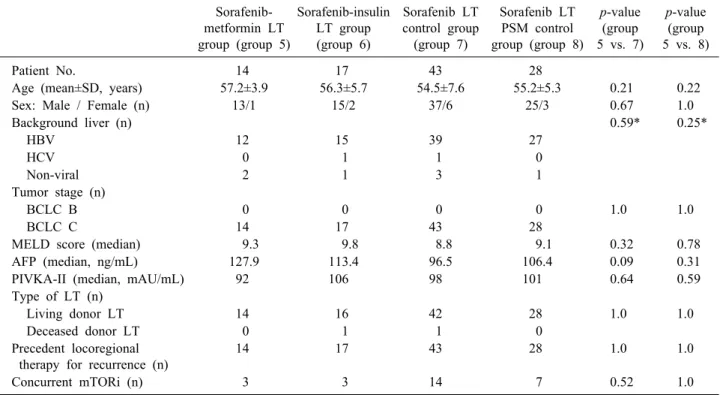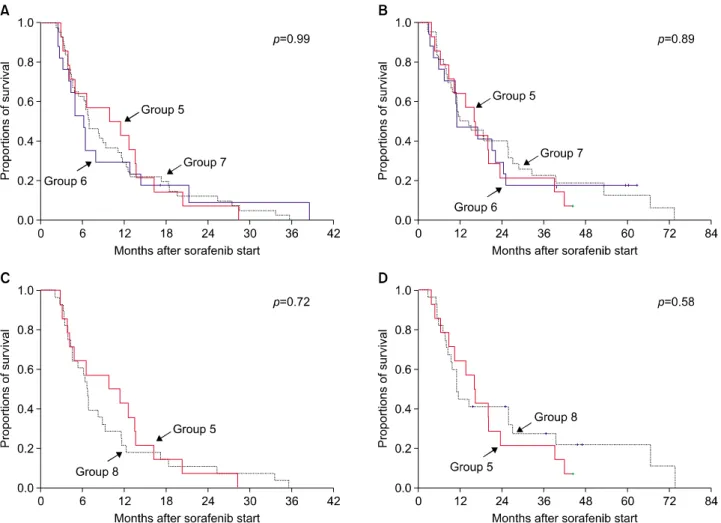Absence of antitumor effects of metformin in
sorafenib-treated patients with hepatocellular carcinoma recurrence after hepatic resection and liver transplantation
Yong-Kyu Chung1, Shin Hwang1, Gi-Won Song1, Young-Joo Lee1, Ki-Hun Kim1, Chul-Soo Ahn1, Deok-Bog Moon1, Tae-Yong Ha1, Dong-Hwan Jung1,
Gil-Chun Park1, Baek-Yeol Ryoo2, and Sung-Gyu Lee1
Departments of 1Surgery and 2Oncology, Asan Medical Center, University of Ulsan College of Medicine, Seoul, Korea
Backgrounds/Aims: Hepatocellular carcinoma (HCC) recurrence following hepatic resection (HR) and liver trans- plantation (LT) remains a great concern. We assessed the antitumor effects of metformin in patients treated with sor- afenib for HCC recurrence after HR or LT. Methods: The two clinical retrospective studies involved metformin therapy of 304 HR patients and 74 LT recipients who were treated with sorafenib. Results: In the study involving patients who had undergone HR, death occurred in 245 of the 304 patients (80.6%) during a median follow-up of 10.2 months after sorafenib administration. The metformin HR group (group 1; n=40) showed no prognostic difference in pro- gression-free and overall survival rates compared with the all-HR control group (group 3; n=241) and propensity score-matched HR control group (group 4; n=80). In the clinical study of recipients exposed to LT, death occurred in 62 of the 74 patients (83.8%) during a median follow-up of 13.6 months (range: 3-76 months) after sorafenib administration. The metformin LT group (group 5; n=14) showed no prognostic difference in progression-free and over- all survival rates compared with the all-LT control group (group 7; n=43) and propensity score-matched LT control group (group 8; n=28). Conclusions: Our clinical studies demonstrated absence of synergistic antitumor effects of metformin. Further high-volume studies are necessary to assess the role of metformin in patients treated with sorafenib for advanced HCC. (Ann Hepatobiliary Pancreat Surg 2018;22:297-304)
Key Words: Diabetic mellitus; Hepatic resection; Metformin; Recurrence
Received: June 6, 2018; Revised: June 10, 2018; Accepted: June 14, 2018 Corresponding author: Shin Hwang
Department of Surgery, Asan Medical Center, University of Ulsan College of Medicine, 88 Olympic-ro 43-gil, Songpa-gu, Seoul 05505, Korea Tel: +82-2-3010-3930, Fax: +82-2-3010-6701, E-mail: shwang@amc.seoul.kr
Copyright Ⓒ 2018 by The Korean Association of Hepato-Biliary-Pancreatic Surgery
This is an Open Access article distributed under the terms of the Creative Commons Attribution Non-Commercial License (http://creativecommons.org/
licenses/by-nc/4.0) which permits unrestricted non-commercial use, distribution, and reproduction in any medium, provided the original work is properly cited.
Annals of Hepato-Biliary-Pancreatic Surgery ∙ pISSN: 2508-5778ㆍeISSN: 2508-5859
INTRODUCTION
Hepatocellular carcinoma (HCC) is one of the most common malignancies and leading causes of cancer-re- lated death. Hepatic resection (HR) is indicated as the first-line treatment in patients with preserved hepatic func- tion, although tumor recurrence is high after curative HR.
Liver transplantation (LT) is also indicated for HCC in patients with impaired hepatic function. Although candi- dates for LT are prudently selected according to the se- lection criteria for HCC, post-transplant recurrence leads to poor outcomes.
HCC recurrence after HR or LT is initially treated with various locoregional therapies; however, tumor pro-
gression renders such treatments refractory. Thus, a con- siderable number of patients undergo systemic chemo- therapy including sorafenib. Sorafenib is currently re- garded as the first-line chemotherapeutic agent for treat- ment of advanced HCC following reports of prolonged survival periods in two randomized controlled trials.1,2 However, the therapeutic effect of sorafenib is often sub- optimal, and most patients experience tumor progression.3 It is imperative to discover adjunct therapies to enhance the therapeutic effects of sorafenib.
In patients with HCC recurrence after HR or LT, vita- min K administration with or without sorafenib occasion- ally showed noticeable antitumor effects.4,5 However, meta-analyses including a randomized controlled trial
Fig. 1. Selection of patients following hepatic resection (HR) and liver transplantation (LT).
have failed to show the antitumor effects of vitamin K.6,7 In a randomized controlled trial, no antitumor or syner- gistic effects of everolimus were detected in patients with advanced HCC receiving sorafenib.8
Metformin is a biguanide used for the treatment of type 2 diabetes mellitus (DM). It inhibits cancer cell growth by inducing cell cycle arrest and enhancing apoptosis.9-12 A considerable number of studies have suggested that metformin plays a chemopreventive role in other cancers and reduces the risk of HCC,13-15 suggesting the antitumor effects of metformin. Recently, it was reported that the combination of metformin and sorafenib suppresses cell proliferation and induces autophagy of HCC in vitro and in vivo by targeting the mammalian target of rapamycin (mTOR) pathway.16 In addition, metformin sensitizes sor- afenib to inhibit postoperative recurrence and metastasis of HCC in mouse models, in which metformin may poten- tially enhance the effect of sorafenib to inhibit HCC re- currence and metastasis after HR.17
Therefore, the present study assessed whether the use of metformin as an adjunct therapy to sorafenib induces synergistic antitumor effects on patients with recurrent HCC following HR or LT.
MATERIALS AND METHODS
Study design
This study comprised two clinical investigations into
HCC recurrence after HR and LT. In the clinical studies, post-treatment survival periods were analyzed to validate the antitumor effects of metformin as an add-on therapy.
The study protocols were approved by the Institutional Review Board of the Asan Medical Center.
Patient selection for the HR cohort
The HCC database at our institution was searched to identify patients who were treated with sorafenib for HCC recurrence after HR during 8 years from January 2009 to December 2016. Patients who discontinued sorafenib treatment for 2 months were not included. Based on this screening process, 304 patients with HCC recurrence who were exposed to sorafenib before May 2017 were selected and divided according to the concurrent administration of metformin or insulin for treating DM. Finally, 40 patients were assigned to the sorafenib-metformin co-medication group (sorafenib-metformin HR group; group 1), 23 to the sorafenib-insulin co-medication arm (sorafenib-insulin HR group; group 2), and 241 to the sorafenib-alone arm (non-DM HR control group; group 3). Patients who were treated with both insulin and metformin were assigned to the sorafenib-metformin co-medication group.
To overcome possible selection bias, propensity score matching (PSM) was conducted between study group 1 and control group 3 using multiple logistic regression and a 1:2 matching requirement via nearest neighbor mat- ching. Baseline characteristics (age, sex), background liver
Table 1. Comparison of clinical profiles at start of sorafenib treatment in the HR groups
Sorafenib- metformin HR group (group 1)
Sorafenib-insulin HR group (group 2)
Sorafenib HR control group
(group 3)
Sorafenib HR PSM control group (group 4)
p-value (group 1 vs. 3)
p-value (group 1 vs. 4)
Patient No. 40 23 241 80
Age (mean±SD, years) 59.4±9.3 61.8±9.9 54.6±11.2 58.1±10.3 0.011 0.94
Sex: Male/Female (n) 36/4 23/0 193/48 64/16 0.14 0.17
Background liver (n) 0.064* 0.49*
HBV 29 17 211 64
HCV 3 1 6 4
Non-viral 8 5 24 12
Tumor stage (n)
BCLC B 1 1 12 2 1.0 1.0
BCLC C 39 22 233 78
MELD score (median) 9.2 8.8 8.7 8.9 0.072 0.43
AFP (median, ng/mL) 122.7 47.3 179.2 137.2 0.091 0.79
PIVKA-II (median, mAU/mL) 71 94 124 86 0.12 0.86
Extent of initial HR (n) 0.94** 0.87**
Trisectionectomy 1 0 3 0
Hemihepatectomy 16 9 105 39
Bisectionectomy 4 1 11 7
Sectionectomy 12 3 76 19
Segmentectomy 1 3 19 5
Partial hepatectomy 6 7 27 10
Precedent locoregional therapy for recurrence (n)
40 23 241 80 1.0 1.0
HR, hepatic resection; HBV, hepatitis B virus; HCV, hepatitis C virus; BCLC, Barcelona Clinic Liver Cancer; AFP, -fetopro- tein; PIVKA-II, proteins induced by vitamin K antagonist or absence-II; MELD, model for end-stage liver disease
*viral vs. non-viral
**sectionectomy and greater vs. segmentectomy and lesser disease (viral hepatitis versus others), level of tumor markers (AFP and proteins induced by vitamin K antago- nist or absence-II) at the start of sorafenib therapy, prece- dent locoregional therapy, total tumor load (sum of intra- and extrahepatic tumor volumes), and duration of sor- afenib administration were matched. Eighty patients were assigned to this PSM non-DM HR control group (group 4).
Patient selection for the LT cohort
The LT database at our institution was also searched to identify patients who underwent LT for HCC over an 11-year period from January 2003 to December 2013, and 1376 of 3248 adult recipients who had undergone LT were selected. Of these, 221 recipients (16.1%) man- ifested post-transplant HCC recurrence until December 2015. Patients who discontinued with sorafenib therapy for 2 months were excluded. Following this screening process, 74 patients were selected and divided according to the concurrent administration of metformin and insulin.
Finally, 14 patients were assigned to the sorafenib–metfor- min co-medication group (sorafenib–metformin LT group;
group 5), 17 to the sorafenib–insulin co-medication group (sorafenib–insulin LT group; group 6), and 43 to the sor- afenib-alone group (non-DM LT control group; group 7) (Fig. 1B). Patients exposed to both insulin and metformin were assigned to the sorafenib–metformin co-medication group.
To overcome possible selection bias, PSM was con- ducted between study group 5 and control group 7 using multiple logistic regression analysis and nearest neighbor matching (1:2). Baseline characteristics (age, sex), back- ground liver disease (viral hepatitis versus others), level of tumor markers at the time of administering sorafenib, prec- edent therapy treatment, total tumor load (sum of intra- and extrahepatic tumor volumes), use of mTOR inhibitor (everolimus or sirolimus), and duration of sorafenib admin- istration were matched. Twenty-eight patients were as- signed to this PSM non-DM LT control group (group 8).
Fig. 2. Comparison of the progression-free survival (A) and overall survival (B) curves after sorafenib administration in hepatic resection groups 1, 2, and 3. After propensity score matching, the progression-free survival (C) and overall survival (D) curves were compared between HR groups 1 and 4.
Patient follow-up
The general principles of treatment for recurrent HCC lesions were applied to HR and LT patients with HCC recurrence.18,19 Patients in the HR and LT groups were followed up until October 2017 with medical record re- view and assistance from the National Health Insurance Service. All patients were completely followed up to de- termine patient survival status. Disease progression was assessed using modified Response Evaluation Criteria in Solid Tumors (RECIST).20 DM treatment was usually pro- vided long before HCC recurrence, thus the pro- gression-free survival period was calculated from the day of sorafenib treatment initiation until the day of docu- mented disease progression or last follow-up. Overall sur- vival was calculated from the day of starting sorafenib ad- ministration until the day of patient death or the last fol- low-up.
Statistical analysis
Continuous variables were reported as mean with stand- ard deviation or median with range and compared using Student’s t-test. Categorical variables were compared us- ing the chi-square or Fisher’s exact test, as appropriate.
Survival curves were generated using the Kaplan-Meier method and compared using the log-rank test. A p-value of <0.05 was considered to indicate a statistically sig- nificant difference. Statistical analyses were performed us- ing SPSS version 22 (IBM, New York, NY, USA).
RESULTS
Clinical study post HR
The patient selection process for the HR groups is out- lined in Fig. 1. The clinicopathological features of the pa- tients in the sorafenib–metformin HR group (group 1),
Table 2. Comparison of clinical profiles at the start of sorafenib administration in the LT groups
Sorafenib- metformin LT group (group 5)
Sorafenib-insulin LT group (group 6)
Sorafenib LT control group
(group 7)
Sorafenib LT PSM control group (group 8)
p-value (group 5 vs. 7)
p-value (group 5 vs. 8)
Patient No. 14 17 43 28
Age (mean±SD, years) 57.2±3.9 56.3±5.7 54.5±7.6 55.2±5.3 0.21 0.22
Sex: Male / Female (n) 13/1 15/2 37/6 25/3 0.67 1.0
Background liver (n) 0.59* 0.25*
HBV 12 15 39 27
HCV 0 1 1 0
Non-viral 2 1 3 1
Tumor stage (n)
BCLC B 0 0 0 0 1.0 1.0
BCLC C 14 17 43 28
MELD score (median) 9.3 9.8 8.8 9.1 0.32 0.78
AFP (median, ng/mL) 127.9 113.4 96.5 106.4 0.09 0.31
PIVKA-II (median, mAU/mL) 92 106 98 101 0.64 0.59
Type of LT (n)
Living donor LT 14 16 42 28 1.0 1.0
Deceased donor LT 0 1 1 0
Precedent locoregional therapy for recurrence (n)
14 17 43 28 1.0 1.0
Concurrent mTORi (n) 3 3 14 7 0.52 1.0
LT, liver transplantation; HBV, hepatitis B virus; HCV, hepatitis C virus; BCLC, Barcelona Clinic Liver Cancer; AFP, -fetopro- tein; PIVKA-II, proteins induced by vitamin K antagonist or absence-II; MELD, model for end-stage liver disease; mTORi, mammalian target of rapamycin inhibitor
*viral vs. non-viral
sorafenib–insulin HR group (group 2), non-DM HR con- trol group (group 3), and non-DM HR PSM control group (group 4) are summarized in Table 1. All patients under- went locoregional therapy for recurrent HCC lesions prior to sorafenib therapy. The clinicopathological features of patients in groups 1 and 3 differed in terms of age, back- ground liver disease, model for end-stage liver disease (MELD) score, and AFP. These differences were not de- tected between patients in groups 1 and 4 after PSM.
During the follow-up with a median of 10.2 months (range: 2-76 months) after sorafenib administration, death occurred in 245 of the 304 patients (80.6%). The median progression-free survival period after sorafenib admin- istration was 4.5 months in group 1; 4.1 months in group 2; 3.1 months in group 3; and 3.0 months in group 4 (p=0.63; Fig. 2A). The median overall survival after sor- afenib administration was 12.1 months in group 1; 11.8 months in group 2; 10.5 months in group 3; and 10.3 months in group 4 (p=0.96; Fig. 2B).
A comparison between patients in groups 1 and 4 re- vealed no difference in progression-free survival rates
(p=0.078; Fig. 2C) and overall survival rates (p=0.10; Fig.
2D) after sorafenib intervention.
Clinical study post LT
The patient selection process for the LT groups is out- lined in Fig. 1. The clinicopathological features of the pa- tients in the sorafenib–metformin LT group (group 5), sor- afenib–insulin LT group (group 6), non-DM LT control group (group 7), and non-DM LT PSM control group (group 8) are summarized in Table 2. All patients under- went locoregional therapy for recurrent HCC lesions prior to exposure to sorafenib. The clinicopathological features of patients in groups 5 and 7 were very similar, except for AFP levels. This difference was not detected between patients in groups 5 and 8 after PSM.
During a median follow-up of 13.6 months (range: 3-76 months) after sorafenib administration, death occurred in 62 of the 74 patients (83.8%). The median progression- free survival period after sorafenib administration was 6.5 months in group 5; 6.1 months in group 6; 6.7 months in group 7; and 6.6 months in group 8 (p=0.99; Fig. 3A).
Fig. 3. Comparison of the progression-free survival (A) and overall survival (B) curves after sorafenib administration in liver transplantation groups 5, 6, and 7. Following propensity score matching, the progression-free survival (C) and overall survival (D) curves were compared between LT groups 5 and 8.
The median overall survival after sorafenib therapy was 15.9 months in group 5; 10.8 months in group 6; 11.4 months in group 7; and 10.9 months in group 8 (p=0.89;
Fig. 3B).
A comparison between patients in groups 5 and 8 re- vealed no difference in progression-free survival rates (p=0.72; Fig. 3C) and overall survival rates (p=0.58; Fig.
3D) after sorafenib administration.
DISCUSSION
Sorafenib is a multikinase inhibitor with therapeutic ef- ficacy against HCC.4 Although sorafenib markedly pro- longs the survival of patients with advanced HCC,8-11 its potential mechanisms of action that induce clinical bene- fits are yet to be established. Metformin is a biguanide that inhibits cancer cell growth by inducing cell cycle ar-
rest and enhancing apoptosis, and is reportedly associated with a reduced risk of HCC.9-15
Metformin treatment mainly induces the inhibition of mTOR pathway, which plays an important role in the me- tabolism, growth, and proliferation of cancer cells.21 Metformin inhibits mTOR pathway via AMP-activated protein kinase (AMPK) activation, which is important for energy homeostasis.22 Metformin also inhibits the mTOR pathway in an AMPK-independent manner.23 The anti- tumor effects of metformin are thought to be mediated via AMPK-dependent and independent pathways. Sorafenib activates AMPK. A clinical study demonstrated that pa- tients with KRAS-mutant advanced non-small cell lung cancer treated concomitantly with sorafenib and metfor- min had better outcomes than those receiving sorafenib alone. The study also showed that sorafenib and metfor- min act synergistically by inhibiting cellular proliferation
in non-small cell lung cancer in vitro and in vivo and by phosphorylating the AMPKα activation site.24 Thus, both sorafenib and metformin appear to activate the AMPK pathway, thus inducing synergistic antitumor effects.
In the current study, we selected two cohorts with tu- mor recurrence after macroscopically curative resection of pathologically proven HCC through HR and LT. Because of the limited number of cases and different patterns and extent of tumor recurrence, it is difficult to assess the anti- tumor effects of sorafenib and metformin in patients who had undergone HR or LT and later diagnosed with ad- vanced HCC recurrence.25 Surprisingly, we found no syn- ergistic effect of sorafenib and metformin in patients who underwent HR and LT.
The antitumor effects of metformin were only demon- strated in high-volume cohort studies or laboratory-based investigations,9-15 implying that potency of the antitumor effect was not sufficient to serve as an independent prog- nostic indicator in small or medium-sized studies. The wide variability of response to treatment in our clinical studies suggests that only a small proportion of patients may benefit from the combination therapy of sorafenib and metformin.
One clinical study with patients with advanced HCC showed poorer outcomes with concomitant sorafenib and metformin intervention compared with sorafenib alone.26 This small-volume retrospective study (n=93) appears to conflict with several in vitro studies showing a synergistic effect and clinical studies demonstrating the chemo- preventive effects of metformin.9-15 Our present study sug- gests that metformin and sorafenib co-treatment is not beneficial from an oncological standpoint, despite the ab- sence of any detrimental effect. Based on this study, it may not be reasonable to intentionally prescribe metfor- min to augment the antitumor effects of sorafenib in HCC patients contraindicated for DM treatment.
This study has a few limitations. Our clinical study was a single-center retrospective study with a limited number of patients. The PSM case-control comparison might not be adequate to overcome the oncological heterogeneity of the study patients. However, a unique strength of this study is that the survival status of all patients was com- pletely followed.
In conclusion, our clinical studies demonstrated no anti- tumor effects of metformin in patients treated with
sorafenib. These findings underscore the need for further high-volume studies to assess the role of metformin in pa- tients exposed to sorafenib for advanced HCC.
REFERENCES
1. Llovet JM, Ricci S, Mazzaferro V, Hilgard P, Gane E, Blanc JF, et al. Sorafenib in advanced hepatocellular carcinoma. N Engl J Med 2008;359:378-390.
2. Cheng AL, Kang YK, Chen Z, Tsao CJ, Qin S, Kim JS, et al.
Efficacy and safety of sorafenib in patients in the Asia-Pacific region with advanced hepatocellular carcinoma: a phase III rand- omised, double-blind, placebo-controlled trial. Lancet Oncol 2009;10:25-34.
3. Davis E, Wiesner R, Valdecasas J, Kita Y, Rossi M, Schwartz M. Treatment of recurrent hepatocellular carcinoma after liver transplantation. Liver Transpl 2011;17 Suppl 2:S162-166.
4. Ha TY, Hwang S, Hong HN, Choi YI, Yoon SY, Won YJ, et al. Synergistic effect of sorafenib and vitamin K on suppression of hepatocellular carcinoma cell migration and metastasis.
Anticancer Res 2015;35:1985-1995.
5. Jung DH, Hwang S, Song GW, Ryoo BY, Kim N, Tak E, et al. An interim safety analysis of hepatocellular carcinoma pa- tients administrating oral vitamin K with or without sorafenib.
Korean J Hepatobiliary Pancreat Surg 2015;19:1-5.
6. Yoshida H, Shiratori Y, Kudo M, Shiina S, Mizuta T, Kojiro M, et al. Effect of vitamin K2 on the recurrence of hepatocellular carcinoma. Hepatology 2011;54:532-540.
7. Zhong JH, Mo XS, Xiang BD, Yuan WP, Jiang JF, Xie GS, et al. Postoperative use of the chemopreventive vitamin K2 analog in patients with hepatocellular carcinoma. PLoS One 2013;8:e58082.
8. Zhu AX, Kudo M, Assenat E, Cattan S, Kang YK, Lim HY, et al. Effect of everolimus on survival in advanced hepatocellular carcinoma after failure of sorafenib: the EVOLVE-1 randomized clinical trial. JAMA 2014;312:57-67.
9. Ben Sahra I, Regazzetti C, Robert G, Laurent K, Le Marchand-Brustel Y, Auberger P, et al. Metformin, independent of AMPK, induces mTOR inhibition and cell-cycle arrest through REDD1. Cancer Res 2011;71:4366-4372.
10. Buzzai M, Jones RG, Amaravadi RK, Lum JJ, DeBerardinis RJ, Zhao F, et al. Systemic treatment with the antidiabetic drug met- formin selectively impairs p53-deficient tumor cell growth.
Cancer Res 2007;67:6745-6752.
11. Dowling RJ, Zakikhani M, Fantus IG, Pollak M, Sonenberg N.
Metformin inhibits mammalian target of rapamycin-dependent translation initiation in breast cancer cells. Cancer Res 2007;67:10804-10812.
12. Zakikhani M, Dowling R, Fantus IG, Sonenberg N, Pollak M.
Metformin is an AMP kinase-dependent growth inhibitor for breast cancer cells. Cancer Res 2006;66:10269-10273.
13. Chen HP, Shieh JJ, Chang CC, Chen TT, Lin JT, Wu MS, et al. Metformin decreases hepatocellular carcinoma risk in a dose-dependent manner: population-based and in vitro studies.
Gut 2013;62:606-615.
14. Donadon V, Balbi M, Mas MD, Casarin P, Zanette G.
Metformin and reduced risk of hepatocellular carcinoma in dia- betic patients with chronic liver disease. Liver Int 2010;30:
750-758.
15. Lai SW, Chen PC, Liao KF, Muo CH, Lin CC, Sung FC. Risk of hepatocellular carcinoma in diabetic patients and risk reduc- tion associated with anti-diabetic therapy: a population-based co-
hort study. Am J Gastroenterol 2012;107:46-52.
16. Ling S, Song L, Fan N, Feng T, Liu L, Yang X, et al.
Combination of metformin and sorafenib suppresses proliferation and induces autophagy of hepatocellular carcinoma via targeting the mTOR pathway. Int J Oncol 2017;50:297-309.
17. You A, Cao M, Guo Z, Zuo B, Gao J, Zhou H, et al. Metformin sensitizes sorafenib to inhibit postoperative recurrence and meta- stasis of hepatocellular carcinoma in orthotopic mouse models.
J Hematol Oncol 2016;9:20.
18. Korean Association for the Study of the Liver. KASL clinical practice guidelines: management of chronic hepatitis B. Clin Mol Hepatol 2016;22:18-75.
19. Hwang S, Lee YJ, Kim KH, Ahn CS, Moon DB, Ha TY, et al. The impact of tumor size on long-term survival outcomes af- ter resection of solitary hepatocellular carcinoma: single-in- stitution experience with 2558 Patients. J Gastrointest Surg 2015;
19:1281-1290.
20. Lencioni R, Llovet JM. Modified RECIST (mRECIST) assess- ment for hepatocellular carcinoma. Semin Liver Dis 2010;30:52- 60.
21. Chiang GG, Abraham RT. Targeting the mTOR signaling net- work in cancer. Trends Mol Med 2007;13:433-442.
22. Gong L, Goswami S, Giacomini KM, Altman RB, Klein TE.
Metformin pathways: pharmacokinetics and pharmacodynamics.
Pharmacogenet Genomics 2012;22:820-827.
23. Kalender A, Selvaraj A, Kim SY, Gulati P, Brûlé S, Viollet B, et al. Metformin, independent of AMPK, inhibits mTORC1 in a rag GTPase-dependent manner. Cell Metab 2010;11:390-401.
24. Groenendijk FH, Mellema WW, van der Burg E, Schut E, Hauptmann M, Horlings HM, et al. Sorafenib synergizes with metformin in NSCLC through AMPK pathway activation. Int J Cancer 2015;136:1434-1444.
25. Perricone G, Mancuso A, Belli LS, Mazzarelli C, Zavaglia C.
Sorafenib for the treatment of recurrent hepatocellular carcinoma after liver transplantation: does mTOR inhibitors association augment toxicity? Eur J Gastroenterol Hepatol 2014;26:577-578.
26. Casadei Gardini A, Marisi G, Scarpi E, Scartozzi M, Faloppi L, Silvestris N, et al. Effects of metformin on clinical outcome in diabetic patients with advanced HCC receiving sorafenib. Expert Opin Pharmacother 2015;16:2719-2725.
